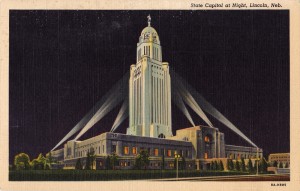American state capitol buildings are traditionally a smaller version of the U.S. Capitol, complete with central dome; you can find them in Montpelier, Harrisburg, Little Rock, and Salt Lake City. The state capitol in Lincoln, Nebraska is different. There is a small gold dome, but it’s on top of a fifteen-storey office tower. The architect was Bertrand Grosvenor Goodhue. He won a 1920 national competition against formidable competition; second and third places were was taken by John Russell Pope and McKim, Mead & White, who both designed classical schemes with the familiar domes. The fourth-place finisher was Paul Cret who dispensed with the dome and proposed a low, building in a simplified classical style, the centerpiece crowned by sculpted buffaloes. Goodhue’s design was even more radical: a free interpretation of classicism that dispensed with columns and entablatures and blended classicism with a Gothic sensibility (Goodhue had designed many Gothic Revival buildings with his then-partner Ralph Adams Cram). The Nebraska building is not a stylistic pastiche, however, more like a modern riff on old themes. The modernity is underscored by the artistic elements in the building, many on prairie themes (including “The Sower” that stands atop the dome), the work of sculptor Lee Lawrie. This was a moment in American architecture when art and architecture happily complemented each other (see Rockefeller Center, where Lawrie also worked, for another example). It was also a moment when architects such as Goodhue and Cret were pushing the boundaries of traditional styles to discover a modern, American version. This remains another one of those “roads not taken,” as European modernism swept the scene, and such stylistic exploration—and artist-architect collaborations—became a thing of the past.


